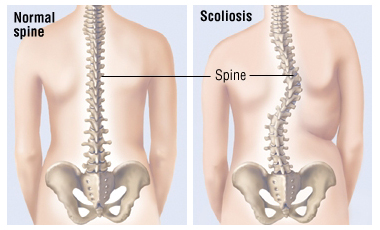
Have you heard about scoliosis ?It is a sideways curvature of the spine that occurs most often during the growth spurt just before puberty. While it can be caused by conditions such as cerebral palsy and muscular dystrophy, the cause of most scoliosis is unknown.
Most cases are mild but some children develop spine deformities that continue to get more severe as they grow. An especially severe spinal curve can reduce the amount of space within the chest, making it difficult for the lungs to function properly.. This disease affect girl more than boys.

Your Plan for Natural Scoliosis Prevention and Treatment: Health In Your Hands, 3rd Edition
Cause
Like other’s spine disease there’s unknown cause for this symptom but some researcher group in 2 cause such as :-
- Nonstructural when the spine is normal. The curvature occurs as the result of another problem.
- Structural when the spine is abnormal. The curvature is caused by another disease process such as a muscular dystrophy, metabolic diseases, connective tissue disorders or birth defect,.
- Neuromuscular conditions, such as cerebral palsy or muscular dystrophy
- Birth defects affecting the development of the bones of the spine
- Injuries to or infections of the spine
Symptoms
Signs and symptoms of may include:
- Uneven shoulders
- One shoulder blade that appears more prominent than the other
- Uneven waist
- One hip higher than the other
Treatment
Isn’t it strange how the spine curves? There are treatment like this :-
- Observation
- Casting
- Bracing
- Surgery
Risk Factors
Risk factors for developing the most common type of scoliosis include:
- Age. Signs and symptoms typically begin during the growth spurt that occurs just prior to puberty. This is usually between the ages of 9 and 15 years.
- Sex. Although both boys and girls develop mild scoliosis at about the same rate, girls have a much higher risk of the curve worsening and requiring treatment.
- Family history. It can run in families, but most children with scoliosis don’t have a family history of the disease.
Complications
Scoliosis may sometimes cause complications, including:
- Lung and heart damage. In severe scoliosis, the rib cage may press against the lungs and heart, making it more difficult to breathe and harder for the heart to pump.
- Back problems. Adults who had scoliosis as children are more likely to have chronic back pain than are people in the general population.
- Appearance. As scoliosis worsens, it can cause more noticeable changes — including unlevel shoulders, prominent ribs, uneven hips, and a shift of the waist and trunk to the side. Individuals with scoliosis often become self-conscious about their appearance.
.
Reference :- Scoliosis SOS Clinic
Mayoclinic

as if lung cancer wasn’t enough here is another reason to quit smoking